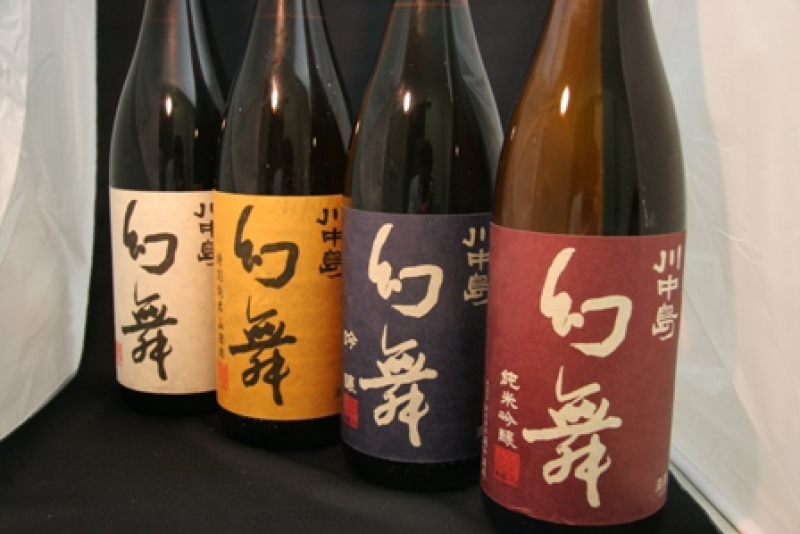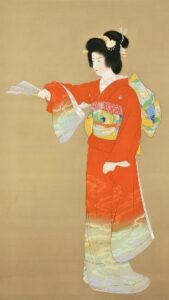
KAWANAKAJIMA GENBU is brewed in Nagano City, Nagano Prefecture.
Where the name KAWANAKAJIMA GENBU came from
Kawanakajima is the name that comes to mind for every Japanese: the Battle of Kawanakajima*1, the general name for the 12-year battle between Kenshin Uesugi and Shingen Takeda over control of the fertile lands of northern Shinano. The brewery, Shusen Kurano, located in the town of Kawanakajima, produces KAWANAKAJIMA GENBU.
The brewery founded in 1540 has a long history. Since the Battle of Kawanakajima took place between 1553 and 1564, the brewery had been making sake before that time.
It is said that Shingen Takeda also drank sake from the Brewery Shusen Kurano (operated under a private name at the time of its founding).
Note 1: The "Battle of Kawanakajima" is the general name for a legendary series of five battles fought over a period of 12 years. Shingen Takeda of Kai and Kenshin Uesugi of Echigo, sworn enemies, fought for control of the northern Shinano region, but despite their long battle, no victory or defeat was ever decided. Since the fierce battle of the fourth battle in 1561 is widely known, the name "Battle of Kawanakajima" is used to include battles fought in other locations, and the term "Battle of Kawanakajima" is generally used to refer to the fourth battle.
(Ref: Touken World HP
https://www.touken-world.jp/tips/7085/)
Sake called KAWANAKAJIMA has been handed down from the time of its establishment. It was a female toji, Ms. Mariko Chino, who breathed new life into the sake. KAWANAKAJIMA is a nigori (cloudy) sake, but Mariko challenged an unprecedented, unfiltered, unpasteurized, freshly pressed sake. And that was KAWANAKAJIMA GENBU.
What is GENBU (幻舞)? The word breaks down to “幻(GEN)” meaning “phantom” and “舞(BU)” meaning “dance”. Mariko says, “I wanted to create a sake that has a transient quality that will quickly disappear like a "phantom," but within that transience is a taste that makes you want to "dance solemnly.” That was the starting point of GENBU.

From KAGIROHI HP
http://kagirohi.art
The image of "Mai" is based on the portrayal of a dignified woman painted by Uemura Shoen.
Note 2:Shoen Uemura (1875-1949) is a Japanese-style painter. Specializing in paintings of graceful beauties, she has established a solitary boundary in her images of women, which she pursues from the unique perspective of a female painter. In 1948, she became the first woman to be awarded the Order of Cultural. Born in Kyoto City. Her real name is Tsune.
https://kyotocity-kyocera.museum/exhibition/20210717-0912)

From KAGIROHI HP
http://kagirohi.art
At the time, the best-selling sake brands had three-lettered names. Mariko was no exception, initially suggesting "Genbu-sui(幻舞翠)" as a possible name for the sake. She chose the letter "sui(翠): jade green" because she wanted to express the delicate transparency of unfiltered sake. “However, we couldn't leave out KAWANAKAJIMA, which has been around since the company's founding,” she says. “Six kanji characters, “川中島幻舞翠“ seemed crowded on one label. So, I gave up with the last kanji and finalized it as “川中島 幻舞:KAWANAKAJIMA GENBU”.
So, “幻舞翠:GENBUSUI" is a name that has truly become a phantom. Mariko's passion for unfiltered, unpasteurized sake must have been brought to life in the present sake in just five characters.
Shusen Kurano’s Line-up

Junmai Nigori (cloudy type)
It is a representative brand of the brewery, made from Nagano Prefecture's best rice for sake brewing, and is a popular product that accounts for about 30% of the brewery's shipments. It is carefully strained, resulting in a smooth and palatable texture.

KATURA-MASAMUNE KINMON
It is for Kawanakajima locals, which has been produced for generations as a casual sake for grandfathers and fathers to drink with dinner.
The series includes a very dry sake called “Mukashi-zake” with an alcohol content of 21.6%, and "Karakuchi type (less dry than Mukashi-zake)" which has a crisp, umami taste.
It is a representative brand of the brewery, made from Nagano Prefecture's best rice for sake brewing, and is a popular product that accounts for about 30% of the brewery's shipments. It is carefully strained, resulting in a smooth and palatable texture.
And of course, Mariko's confident KAWANAKAJIMA GENBU series



(unfiltered, unpasteurized, using Yamada-nishiki brewery rice)
GENBU has a stronger aroma and umami compared to KAWANAKAJIM Junmai and KATSURA MASAMUNE.
It is brewed with a desire for everyone to enjoy the moment of freshly pressed sake with its gorgeous aroma, which only brewers could experience in the past. Since only four brewers are engaged at present, the series is sold as a limited edition due to the time and labor required.
The calligraphy on the labels of KAWANAKAJIMA, KATSURA-MASAMUNE, and GENBU are all written by calligrapher Seiun Kasahara.
About the Brewery, Shusen Kurano


As mentioned above, the history of Shusen Kurano dates back more than 480 years (founded in 1640), and the name has changed from Chino Taemon Sake Brewery derived from the founder’s name to Chino Sake Brewery and then to the present, Shusen Kurano, with the Chino family continuing the family business from generation to generation. However, the Chino family is a female-headed family. Since sake brewing was a world strictly closed to women, the Niigata toji group (master brewers) has been in charge of sake brewing for generations.
Although Mariko was born the only daughter of a brewer, sake brewing was totally out of her future scope. However, she had an interest in her family business, so she entered a university specializing in brewing to learn more about what her family was doing. She then went on to train at the brewing institute of NRIB (now the National Research Institute of Brewing, Hiroshima Prefecture) in Takinogawa, Kita-ku, Tokyo.
The more she learned, the more her desire to make her own sake grew. She eventually returned to her hometown to take over the family business. However, it was not an easy start, she was not allowed to even enter the brewery. The brewing business was totally the world of men.
Begging the toji (master brewer) to let her in, she managed to step into the brewery, but there she was allowed only to watch the work, far from being recognized as a brewer.
“Sake brewing is all about harmony. There is a 'flow' to the process, and it is inexcusable to disturb it. So, I just watched the toji-san work in silence," Mariko recalls.
A few months later, one day, one of the brewers was absent due to illness. There, Mariko was allowed to join the "harmony" group to help with the work. She says that what she had seen and learned came useful, and she was able to enter naturally without disrupting the harmony.
Five years later, with the encouragement of those around her to make her own sake, she decided to brew GENBU.
In the old days, there was no text or face-to-face training. Mariko recalls, “it was the days when senior toji did not explain things. They believed explaining would stop the flow. Listen to Moromi (mash). Feel and learn. Just like that. And my grandmother in the first place was against women making sake. She did not change her policy until the very end”. We can imagine the hardships she went through as a pioneer of female toji.


Since then, Mariko has continued to take on new challenges, most recently with the release of KAWANAKAJIMA SILKY WHITE, a creamy junmai nigori (cloudy) sake made with rice and water both from Shinshu, and KAWANAKAJIMA FUWARIN (fluffy), an unpasteurized sake fermented in the bottle. Both are said to have a low alcohol content, recommended to be served in a champagne glass.

Shingen Takeda, who drank sake at Kawanakajima, would not have believed that the sake has been passed down through the generations by a female toji, changing its form along with the times.
Lastly from Ms. Mariko:

"When you encounter KAWANAKAJIMA, I strongly recommend you to try JUNMAI NIGORI (cloudy) sake.
It has been brewed since the Age of Provincial Wars (late 15th century to late 16th century) and was presented to Shingen Takeda when he came to the nearby mountains. It could be said to be the origin of the brewery.
And for GENBU of course, enjoy the umami of rice."
Interview Date: July 22, 2022 (Telephone)
Interviewee: Ms. Mariko Chino, Toji of Shusen Kurano, Inc.
Image Data Presented by: Shusen Kurano
Interview Note:

I first encountered GENBU at a nearby Sanuki Udon restaurant (Mugifuku: Chikusa-ku, Nagoya City). The owner of the restaurant seemed to be a big GENBU fan and let me try a GENBU flight. Delicious!
Since then, I came to order GENBU when I saw it there, but I had no idea that it was a hard-to-find sake.
The interview was conducted over the telephone for the first time. It was pity that I could not talk to her face-to-face, but Mariko's voice and tone were very soft and gentle that it was hard to believe that she is engaged in the hard, labor-intensive world of sake brewing.
Thank you very much for sharing the story of Shingen Takeda and the hardships faced by female toji. Now, I feel the world of GENBU has expanded wider and deeper.
I look forward to someday encountering the KAWANAKAJIMA JUNMAI NIGORI sake, highly recommended by Mariko.
A trivia entre nous:

Did you realize that the name of the brewery, "Shusen Kurano (酒千蔵野)," can be changed to "Chino Shuzo(千野酒造)" by changing the order of the letters? Wow, it’s Chino Brewery! I didn't know there was such a sense of fun hidden in the name.
It made me want to brag about it.


